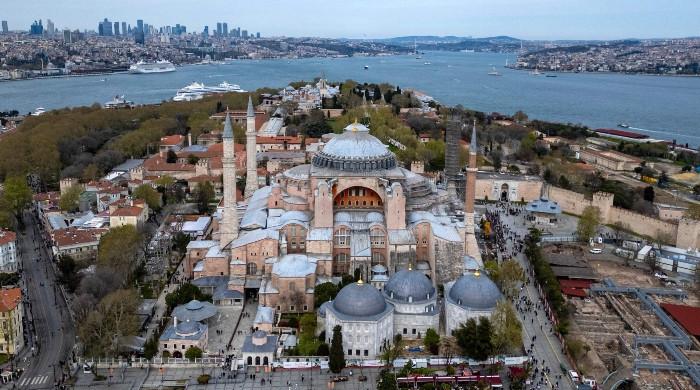Istanbul’s Hagia Sophia Undergoes Extensive Restoration to Withstand Future Earthquakes
The Hagia Sophia in Istanbul has experienced numerous transformations throughout its long history. This architectural marvel has served as a church, a mosque, a museum, and then a mosque again.
Currently, the Hagia Sophia is undergoing a renovation project with the dual aim of restoring its splendor and ensuring its structural integrity against future earthquakes that may strike the city.
From a distance, the iconic dome, shimmering stone, and slender minarets of the Hagia Sophia give the impression of timelessly watching over Istanbul. However, upon closer inspection, scaffolding can be seen enveloping its eastern facade and one of the minarets.
Abdullah Yilmaz, a tour guide, noted that while the renovation and scaffolding might slightly detract from the building’s exterior appearance, they are essential.
Hasan Firat Diker, an architecture professor involved in the restoration, stated that Hagia Sophia, recognized as a World Heritage Site and Turkiye’s most-visited landmark, faces constant structural challenges. This is the main reason why the building has been subjected to numerous repairs over the centuries.
Comprehensive Restoration
This current restoration marks the first comprehensive effort to overhaul the entire site, including the dome, walls, and minarets, according to Diker.
Originally completed in AD 537, Hagia Sophia was celebrated as a prime example of Byzantine architecture during the era when Constantinople was under Byzantine rule.
It functioned as a church until the Ottoman conquest in 1453, after which it was converted into a mosque.
In 1935, Mustafa Ataturk, the founder of modern Turkey, transformed the building into a museum as part of his secular reforms.
The structure remained a museum until 2020 when President Recep Tayyip Erdogan, adhering to his Islamic-rooted political views, reconverted it into a mosque.
Preparing for Seismic Activity
Similar to the inhabitants of Istanbul, the Hagia Sophia has faced challenges, including the constant threat of earthquakes.
The structure is located just kilometers from an active seismic fault line. Hagia Sophia does not meet current earthquake safety standards.
The structure’s dome collapsed during an earthquake in 558, and subsequent earthquakes have caused additional damage.
Ahmet Gulec, a member of the scientific committee overseeing the restoration, explained that the primary goal of the ongoing work is to reinforce the building against future earthquakes, ensuring it sustains minimal damage.
Currently, experts are analyzing the dome to determine the best methods for reinforcement and restoration.
The interior of the Hagia Sophia is currently free of scaffolding. However, plans include erecting four large pillars inside to support a platform for specialists to restore the dome’s paintings and mosaics.
Ana Delgado, a tourist from Mexico, expressed her awe, stating that the interior felt “perfect.” Elias Erduran, from the Dominican Republic, added that it felt “magic.”
Popular Destination
Last year, Hagia Sophia welcomed 7.7 million visitors.
Approximately 2.1 million of these visitors were foreign tourists, many of whom paid 25 euros for admission, generating millions of euros in revenue.
Officials hope that the internal pillars will not discourage visits during the restoration, which is projected to last several years. The total cost of the renovation has not been disclosed.
Gulec emphasized that the intention is to allow visits and prayers to continue throughout the restoration process.
Yana Galitskaya, a visitor from Russia, expressed that even if some visitors are disappointed by the ongoing work, the important thing is that future generations will have the opportunity to appreciate the Hagia Sophia.



Comments (0)
No comments yet. Be the first to comment!
Leave a Comment